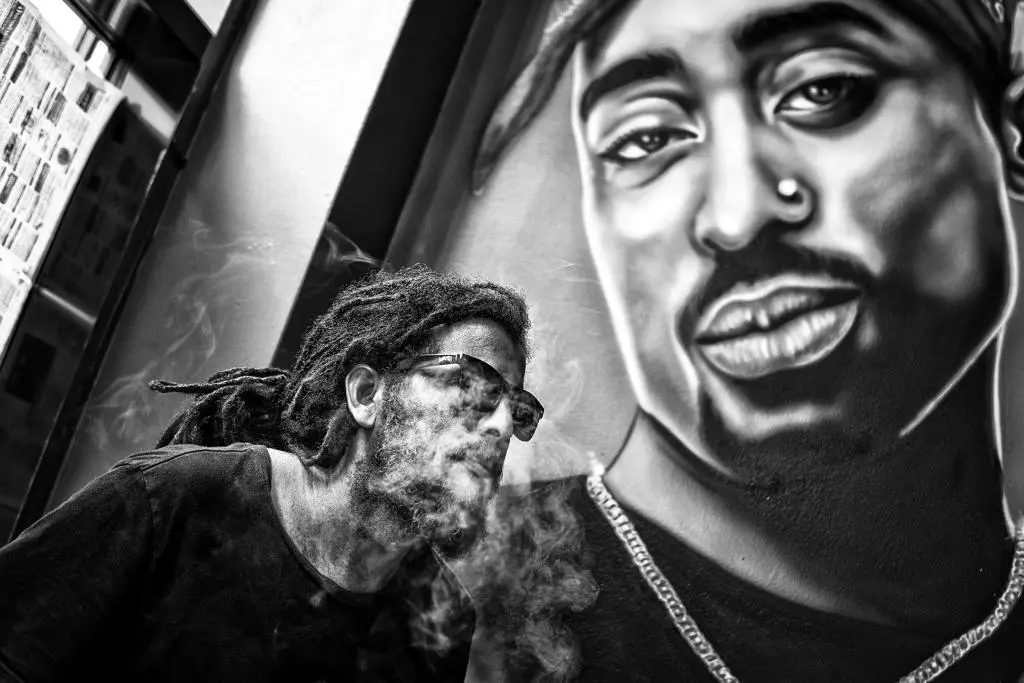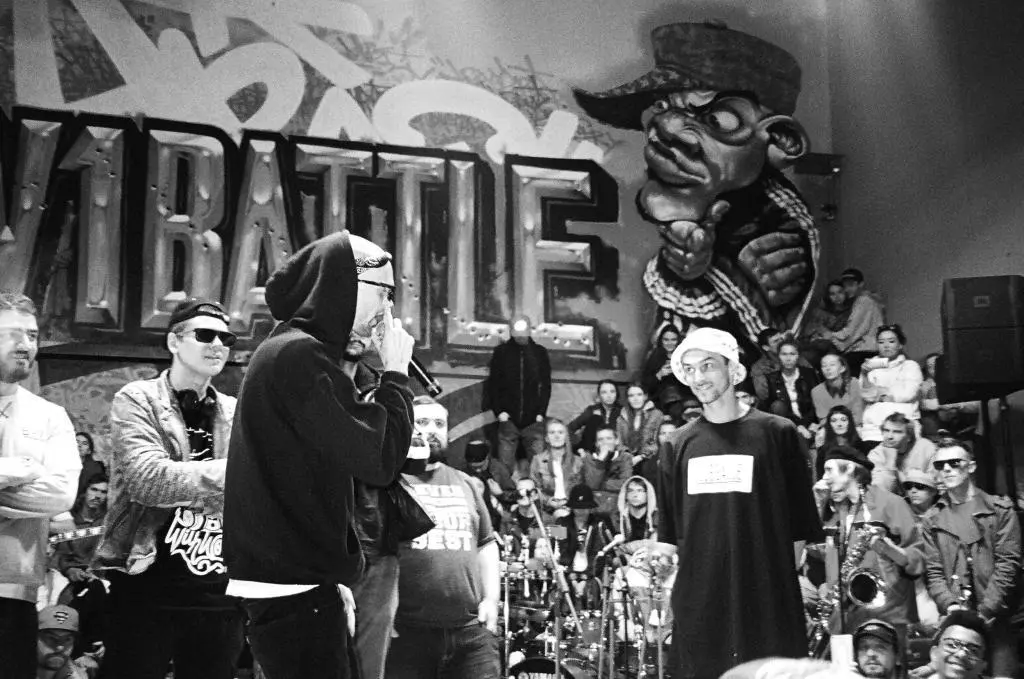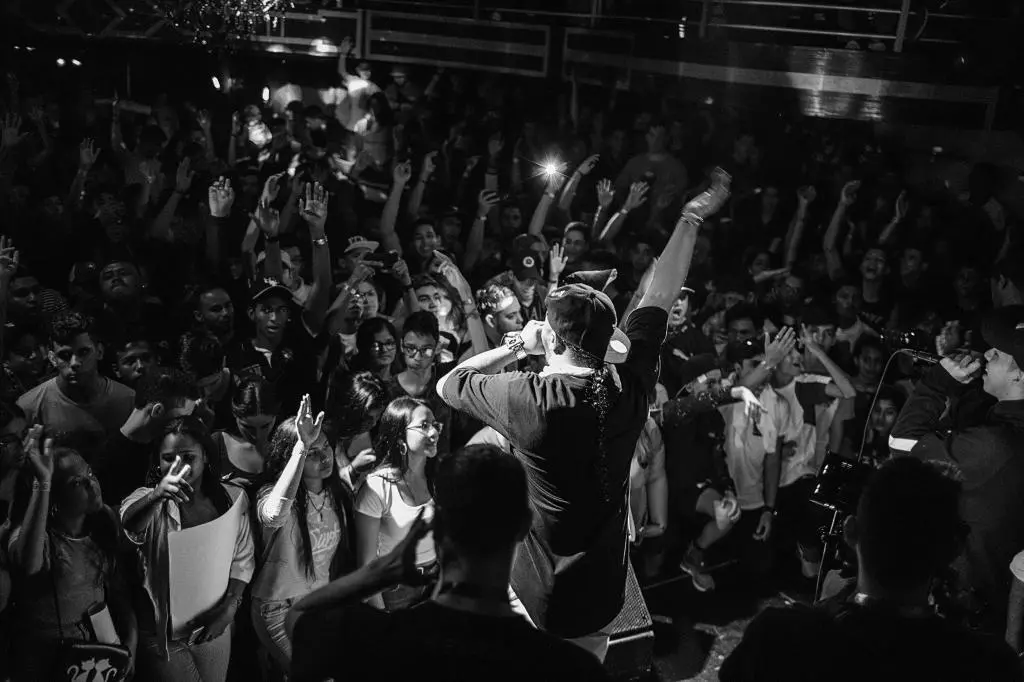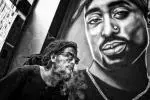Rapping is a musical technique that involves rhythmic speech delivered over a beat. The rapper recites lyrics that rhyme and tell a story as they flow in time with the music. Rapping is a key element of hip hop music and culture.
Beyond this simple definition, rapping has become one of the most groundbreaking and influential music genres over the last 50 years. Since its origins in the 1970s, rap music has risen from the streets of the South Bronx to become a dominant cultural and commercial force across the globe.

What is Rapping: Table of Contents
Rapping was born as a form of expression and creativity among young African Americans, but it has expanded far beyond those roots. Hip hop and rap now provide the soundtrack to youth culture worldwide, shaping everything from fashion and language to social views and political engagement.
The worldwide popularity of rap speaks to its infectious beats, clever wordplay, competitive spirit, and ability to voice stories from overlooked communities. Rappers have become pop culture icons and influencers, while rap lyrics dissect complex issues like racial injustice, poverty, identity, and life in the inner city.
Rap’s cultural impact derives from its raw authenticity and honesty. Rappers pull no punches as they tackle provocative topics with bold rhymes and punchy delivery. As rap continues evolving across nations and generations, this bold originality remains at its core.
Rapping requires athletic vocal skills, lyrical talent, swagger, and the ability to think on your feet. The genre has created opportunities for marginalized youth to gain fame and fortune by demonstrating their verbal dexterity over hot beats. For 50 years and counting, rapping has provided the soundtrack for rebellious youth seeking to blaze their own trails.
History of Rapping
Rapping did not emerge spontaneously in the Bronx – it evolved from a rich mix of cultural and musical influences. The roots of rapping stretch back through history and across continents.
Origins and Influences
West African Oral Traditions
The griots of West Africa, often revered as “oral historians,” have been instrumental in preserving the region’s history and culture for centuries. These griots, using instruments like the kora and balafon, narrated stories, fables, and historical accounts through a blend of rhythmic speech and melodic song. This storytelling art, passed down through generations, laid the foundational techniques for rapping. The emphasis on rhythm, rhyme, and narrative in griot performances deeply resonated with African American communities, bridging ancestral practices with modern artistic expressions.
Blues and its Evolution
The blues, with its soulful melodies and poignant narratives, played a significant role in shaping rapping. Early blues artists, such as the Memphis Jug Band, pioneered a style known as “talking blues,” where rhythmic and lively lyrics reflected the African American experience. This style bore a striking resemblance to rap’s flow, marking a clear lineage between the two. Grammy-winning blues musician/historian Elijah Wald and others have posited that blues artists were essentially rapping as early as the 1920s. Wald even described hip hop as the “living blues” of its time. Joe Hill Louis’s 1950 song “Gotta Let You Go” stands as a testament to this early form of rapping within the blues genre.
Jazz and its Influence
Jazz, another genre deeply rooted in African American culture, brought forth elements that enriched rapping. Jazz poets, merging spoken word with jazz rhythms, laid the groundwork for rhythmic spoken delivery in rap. Scat singing, a vocal improvisation with nonsensical syllables, emphasized rhythm and spontaneity, traits quintessential to freestyle rapping. Artists like boxer Muhammad Ali, who was known for his rhythmic taunts and poetic proclamations, and Gil Scott-Heron, who combined socio-political commentary with rhythmic spoken word, bridged the gap between poetry and rap.
Caribbean Influence
During the mid-20th century, the Caribbean’s musical culture was in constant flux, influenced by the evolving American music scene. As early as 1956, deejays in the Caribbean were “toasting” over dubbed Jamaican beats, a precursor to modern rapping. This style was termed “rap,” an expansion of the word’s earlier meaning in the African-American community, which was “to discuss or debate informally.”
Proto-rap and Early Influences
The early rapping of hip-hop developed from DJ and Master of Ceremonies’ announcements made over the microphone at parties, evolving into more complex raps. Grandmaster Caz, a pioneering figure in hip-hop, describes how the microphone was initially used for making announcements at parties. Over time, different DJs began embellishing what they said, leading to the evolution of lines into sentences, paragraphs, verses, and rhymes. DJ Kool Herc, often regarded as hip-hop’s first DJ, started delivering simple raps at his parties. Some argue that his style was inspired by the Jamaican tradition of toasting, although Herc himself denies this link.
Transition from Disco to Rap
With the decline of disco in the early 1980s, rap emerged as a new form of expression. Rap was a departure from the orchestrated and ritzy multi-tracks of Disco, seeking a more simplified manner of production. The early productions of rap after Disco focused on “break beats,” which were created by compiling records from various genres. This shift marked the development of rap as “anti-Disco.”
Old-school Hip Hop and Golden Age
The late 1970s to early 1980s, often referred to as the “old-school” era of hip hop, was characterized by relatively simple raps. However, the mid-1980s to early ’90s, termed the “golden age” of hip hop, witnessed a transformation in rap lyricism. During this period, artists like PE’s Chuck D, Big Daddy Kane, KRS-One, and Rakim revolutionized lyrical techniques, setting the stage for future generations of rappers.
Development of Hip Hop Culture
Hip hop, as a cultural phenomenon, found its roots on the streets of New York’s Bronx borough in the early 1970s. It was more than just a genre of music; it was a movement that encompassed various forms of expression, from music to art to dance.
DJing and the Birth of a New Sound
DJ Kool Herc, an immigrant with Jamaican roots, is often credited as one of the founding fathers of hip hop. He introduced massive sound systems, reminiscent of those in his native Jamaica, to the parties he hosted. But what truly set him apart was his innovative technique of extending instrumental breaks in songs. These breaks provided a rhythmic base for MCs to chant or rap over, ensuring the energy at parties remained high. This symbiotic relationship between the DJ’s beats and the MC’s raps was the cornerstone of early hip hop.
Afrika Bambaataa, another pivotal figure, was instrumental in shaping the cultural direction of hip hop. He emphasized the importance of community, knowledge, and unity, laying the groundwork for hip hop’s socio-political potential.
Turntablism: An Art Form
While DJing laid the foundation, turntablism elevated the craft to an art form. DJs like Grandmaster Flash and Grandwizard Theodore were not just playing records; they were manipulating them. Techniques like scratching, beat juggling, and needle dropping transformed the turntable into a musical instrument in its own right.
MCing: The Voice of Hip Hop
While the DJs provided the beats, the MCs gave hip hop its voice. Early MCs like Coke La Rock and Melle Mel didn’t just rap; they were storytellers, commentators, and crowd controllers. They developed techniques that are foundational to rapping: boasting raps that highlighted their skills, using rhythmic lines that flowed seamlessly with the beats, and employing call-and-response choruses that engaged and energized audiences.
Influence from the Streets and Beyond
The streets of the Bronx were alive with various influences that contributed to the birth and evolution of hip hop. Graffiti art, with its vibrant colors and intricate designs, gave the movement a visual identity. Breakdancing, with its acrobatic moves and battles, added a dynamic physical element.
Stylistic Changes
Old school rapping from the late 1970s to early 1980s had simple lyrics and flows. Melle Mel expanded rapping’s horizons by incorporating socio-political themes.
The golden age of the late 1980s to early 1990s saw rapid innovations in lyrical dexterity and complexity. Rakim, Big Daddy Kane, KRS-One pushed rapping boundaries with multi-syllabic rhymes, metaphorical depth, and slick wordplay.
Distinct regional styles also blossomed on the East and West Coasts and the South. Rappers formed collectives like Wu-Tang Clan that developed unique local sounds and rapping techniques.
Rapping continues evolving rapidly to this day, but its core elements persist – rhythm, rhyme, wordplay, flow, and always pushing the limits of vocal expression.
Elements of Rapping
Rapping requires mastery of various vocal and lyrical techniques that work together to create captivating hip hop music. A few core elements form the foundation of elite rapping skills.
Rhyme
Rhyme is the bedrock of rapping. MCs use complex rhyme schemes with multisyllabic and internal rhymes to showcase verbal dexterity. Devices like alliteration and assonance also expand rhyming possibilities.
Rappers bend the rules of rhyme to discover new lyrical frontiers. Rhyming technique is intrinsic to the poetry and wordplay of hip hop.
Rhythm and Flow
A rapper’s sense of rhythm and flow is crucial. Flow refers to the cadence and rhythms of the lyrics. Rappers align words and syllables to the beat through techniques like stressed syllables.
Styles of flow range from rapid-fire and percussive to mellow and conversational. Regional flows also developed, like Migos’ iconic triplet flow. But all flows involve riding the rhythm smoothly.
Delivery
A rapper’s vocal delivery encompasses tone, pacing, inflection, and projection. Enunciation and breath control enable clear lyrics. Delivery laces the lyrics with personality and emphasis.
Call-and-response, melody, exaggeration, and other vocal flourishes augment the delivery. A unique delivery differentiates great rappers.
Subject Matter
Rappers touch on endless topics, from bragging about prowess to vulgar party lyrics. But skilled MCs also master storytelling, humor, wordplay, and “battling.”
Conscious rappers like Public Enemy and Kendrick Lamar address racism, inequality, violence and injustice in communities. Rappers provide unfiltered perspectives from urban life.
Elite rappers blend rhythm, rhyme, flow, delivery, and lyrics into a harmonious package conveying attitude, skill, and feeling.

Rapping Techniques
Mastering the technical elements of rapping is crucial, but MCs also need to develop key skills for elite rapping. Three main techniques set great rappers apart.
Freestyling (Improvisation)
Freestyling stands as one of the most revered techniques in the rapping community. It’s the art of improvisation, where rappers craft lyrics on the spot, without any prior preparation. Think of it as a high-wire act, where the rapper walks the tightrope of rhythm and rhyme, relying solely on their wit, creativity, and presence of mind.
Freestyling is not just about spontaneous lyricism; it’s a testament to a rapper’s skill, showcasing their ability to think on their feet, connect with the audience, and ride the beat, all while maintaining a coherent narrative. It’s rapping in its rawest form, unfiltered and unscripted.
Battle Rapping
The arena of battle rapping is where lyrical gladiators clash, trading verses in a competitive showdown. It’s a high-stakes game of wit, wordplay, and bravado. In this arena, rappers go head-to-head, aiming to outperform their opponent with sharper lines, clever disses, and impeccable delivery.
Battle rapping is not just about lyrical prowess; it’s also about performance, stage presence, and the ability to connect with the audience. It’s a platform where rappers showcase their skills, defend their honor, and earn street cred. The battles can be fierce, the disses scathing, but at its core, battle rapping is a celebration of the competitive spirit of hip hop.
Writing Lyrics
While freestyling and battling might be the flashier aspects of rapping, the heart and soul of the art lie in writing lyrics. This is where rappers pour their thoughts, emotions, and experiences onto paper, crafting narratives that resonate with listeners.
Writing lyrics is a meticulous process. It involves choosing the right words, constructing intricate rhyme schemes, and building a narrative that flows seamlessly. It’s about painting vivid pictures with words, telling stories that captivate, and conveying messages that provoke thought.
Whether it’s penning verses about personal struggles, societal issues, or tales of love and loss, writing lyrics is the foundation upon which rapping is built. It’s the canvas where rappers express their creativity, leaving an indelible mark on the annals of hip hop history.

Rapping Genres and Subgenres
Rapping, as an art form, has never been static. Over the decades, it has evolved, branched out, and fused with other genres, giving birth to a myriad of styles and subgenres. This diversity is a testament to the adaptability and expansive nature of rapping, allowing it to resonate with audiences across different cultures and musical tastes. Let’s explore the rich tapestry of rapping genres and subgenres that have shaped the soundscape of hip hop.
Regional Styles
The United States, as the birthplace of hip hop, has seen the emergence of distinct regional styles, each bringing its unique flavor to the world of rapping.
- East Coast Rap: Originating from the urban hubs of New York and Philadelphia, East Coast rap is known for its complex lyricism, intricate wordplay, and jazz-infused beats. Icons like Notorious B.I.G., Nas, and Jay-Z have epitomized this style, weaving tales of city life with unmatched lyrical prowess.
- West Coast Rap: With its roots in Los Angeles and the Bay Area, West Coast rap is characterized by its laid-back, funk-infused beats and gangsta narratives. From the G-funk melodies of Dr. Dre to the revolutionary verses of Tupac Shakur, West Coast rap has left an indelible mark on hip hop culture.
- Southern Rap: Emerging from the vibrant scenes of Atlanta, Houston, and New Orleans, Southern rap brings a blend of crunk energy, trap rhythms, and soulful melodies. Artists like OutKast, Lil Wayne, and Migos have championed this style, adding a distinct southern twang to the world of rapping.
- Midwest Rap: Hailing from cities like Chicago, Detroit, and Cleveland, Midwest rap is a melting pot of styles, known for its fast-paced flow, introspective lyrics, and innovative beats. Artists like Eminem, Kanye West, and Bone Thugs-N-Harmony have showcased the versatility and depth of Midwest rap, blending soul, gospel, and rock influences.
- Dirty South Rap: A subgenre of Southern rap, the Dirty South sound is synonymous with deep basslines, catchy hooks, and a party vibe. Originating in the 90s, it was popularized by artists like Ludacris, UGK, and Master P, who celebrated the southern lifestyle with anthems that resonated across clubs nationwide.
- Pacific Northwest Rap: While not as mainstream as other regions, the Pacific Northwest, encompassing areas like Seattle and Portland, has a burgeoning rap scene. Known for its indie and underground vibe, artists like Macklemore have brought attention to the region with hits that blend pop sensibilities with authentic rap narratives.
Fusion Genres
As rapping gained global popularity, it began to meld with other musical genres, leading to the birth of fusion styles that expanded the boundaries of hip hop.
- Rap Rock & Rap Metal: A powerful amalgamation of rapping and rock/metal instrumentation, this genre is characterized by its aggressive beats and rebellious lyrics. Bands like Linkin Park, Rage Against the Machine, and Limp Bizkit have pioneered this fusion, blending the raw energy of rock with the rhythmic flow of rap.
- Hip House: A vibrant blend of rapping and house music, hip house is all about infectious beats and danceable rhythms. Originating in the late 1980s, this genre saw rappers collaborating with house DJs, producing tracks that lit up dance floors across the globe.
- Jazz Rap: A sophisticated fusion of jazz and hip hop, jazz rap incorporates jazz’s instrumentation and atmosphere into the rhythmic and poetic framework of hip hop. Groups like A Tribe Called Quest and De La Soul have been pivotal in the development of this genre.
- Electro Rap: A genre that emerged in the early 1980s, blending the futuristic sounds of electronica with the rhythmic delivery of rap. Artists like Afrika Bambaataa have been instrumental in shaping this electronic-infused rap sound.
- Rap R&B (Hip Hop Soul): Combining the melodic elements of R&B with the rhythmic and lyrical elements of rap, this genre often features soulful singing interspersed with rapping. Artists like Mary J. Blige and Lauryn Hill have been at the forefront of this fusion.
- Grime: Originating in London, grime is a blend of electronic music and rap, characterized by its rapid breakbeats and aggressive lyrical content. Artists like Stormzy and Dizzee Rascal have popularized this UK urban sound.
- Trap EDM: A genre that combines the high-energy drops of EDM with the rhythmic beats of trap music. Producers like RL Grime and Baauer have been instrumental in shaping this dance-centric rap fusion.
These fusion genres underscore the versatility of rapping and its ability to transcend traditional musical boundaries, creating innovative and captivating sounds.
Rapping in Culture
Rapping, more than just a musical genre, has become a cultural phenomenon. Its influence permeates various facets of society, from language and fashion to politics and identity. The cultural footprint of rapping is vast, and its impact is undeniable. Let’s delve into how rapping has intertwined with and influenced broader cultural narratives.
Spread of Hip Hop Slang into Mainstream
The lexicon of hip hop has found its way into everyday parlance, making “hip hop slang” a linguistic trendsetter. Terms like “lit,” “dope,” and “flex” have transcended the confines of the rap scene, becoming staples in mainstream conversations. This integration showcases the power of rapping as a cultural influencer, shaping the way we speak and express ourselves. The adoption of hip hop slang by the masses is a testament to rapping’s pervasive influence, bridging the gap between underground scenes and popular culture.
Rappers as Cultural Icons and Influencers
From the streets of the Bronx to global arenas, rappers have risen to become cultural titans. Icons like Tupac Shakur, Jay-Z, and Kendrick Lamar are not just musicians; they are trendsetters, activists, and influencers. Their lyrics resonate, their fashion choices become global trends, and their opinions shape public discourse. Rappers have transitioned from being mere entertainers to influential figures, wielding power in industries ranging from fashion and film to politics and entrepreneurship. Their journeys underscore the transformative power of rapping, turning MCs into global icons.
Race, Identity, and Cultural Politics of Rap Music
At its core, rapping is a voice for the marginalized, a platform for the unheard. It delves into the intricacies of race, identity, and cultural politics, offering commentary on societal issues. Through verses, rappers address racial profiling, police brutality, economic disparities, and identity struggles. They challenge stereotypes, confront systemic racism, and celebrate their roots. Rapping becomes a medium for social activism, a call for change, and a reflection of cultural dynamics. It’s not just music; it’s a movement, a reflection of society’s triumphs and tribulations.

